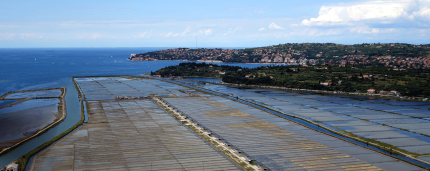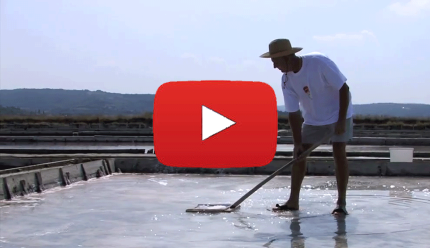sLOVEnia green: The Sečovlje Salina Nature Park
Saltmaking has led to Sečovlje Salina Nature Park to create its own identity and to provide the local community with a source of income and a wide array of activities to foster sustainable tourism inside this protected area.
Sečovlje Salina Nature Park
The Sečovlje Salina Nature Park lies in the southwestern part of Slovenia and covers 750 ha. These saltpans are known to have been formed at the mouth of the Dragonja River during the Middle Ages; however it is suspected that they were first formed as early as Roman times. Over time, the saltpans were co-created by man.
The park is divided into two parts: the northern part (Lera), where salt production is still ongoing, and the southern area (Fontanigge). The latter is home to the ruins of houses of the saltpan workers, which were used up until the end of the 1960s (KPSS 2010) and give us a real insight into the history of salt production. These settlements, along with the saltpans, are an important factor in the creation of the cultural landscape (KPSS 2011).

The Sečovlje Saline Nature Park - Lera. Photo by Tina Primožič.
Sustainable tourism activity in the Park
The park is open all year round. At the entry points, visitors are informed about key rules of conduct (KPSS 2011):
- Tours: An individual or guided tour around the Lera saltpans. The guide presents the Park (flora, fauna, and cultural heritage) and the process of producing salt;
- Salt experience: "Become a Saltpan worker for a day". Visitors can experience salt harvesting with traditional salt-making tools (KPSS 2010);
- The Museum of salt-making: is in one of the renovated houses. The museum can be reached by boat, bike, by foot, and only with exception by bus (KPSS 2011);
- Bird watching: all seasons are suitable for birdwatching, but the most fascinating are spring and autumn. The Birdwatching programme takes 3 hours. The maximum number of participants is 12;
- Walking, cycling and other activities in the park: the existing park infrastructure comprises of several walking and cycling routes with a total length of 9.1km. Within the Park, there is information and educational infrastructure for raising awareness (KPSS 2011);
- Open-air thermal complex: was opened in 2013 as thermal complex Thalasso Spa Lepa Vida. In the complex itself, due to nature protection measures, it is not possible to spend the night (Soline 2013);
- Brand products: the operator has developed a trademark to identify and represent products related to the park (KPSS 2011);
- Meetings and minor events: some meetings and events have become recognisable among visitors and the local community - in particular, the regular annual cleaning campaign in the park, ex-tempore paintings, The Saltpans Feast, nature protection exhibitions, workshops and lectures (KPSS 2011).
The Sečovlje Saltpans are, besides the Strunjan Saltpans, one of the last saltpans in the Mediterranean, where salt is obtained manually with a method which is several hundred years old. Today, the economic role of the saltpans is subjected to the nature conservationist and cultural roles. The preservation of the saltpans’ heritage contributes to the preservation of cultural heritage; the saltpan area is giving a shelter to rare animal and plant species and, whilst being a reserve for an ecologically precious environment is the remains of a once rich Mediterranean cultural heritage which is rapidly disappearing.
Welcome to the Land of Salt
Discover Sečovlje Salina Nature Park through the video presentation "Welcome to the Land of Salt":

Video - Welcome to the Land of Salt
